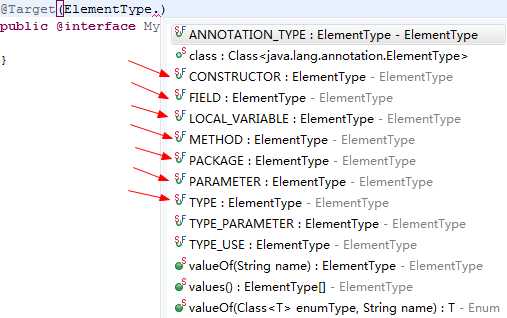注解简单来说就是配置,是特别的配置,之前常用的配置文件,可以用注解替换。然后通过反射去获取注解的信息。
如何定义一个注解
你在IDE中新建一个注解定义,是这样的结构的:
package com.nicchagil.exercise.springbootexercise.annotation;
public @interface MyFirstAnnotation {
}然后大概有4个对上述结构加上一些配置,当然,这配置是以注解的形式添加的=_=!
此注解使用在哪里
此注解会应用的哪里,可通过如下配置:

保留在什么时候
保留到什么时候:

注解体现在文档中
@Documented
子类是否继承父类的注解
@Inherited
用反射获取注解的信息
我们先定义一个注解:
package com.nicchagil.exercise.springbootexercise.annotation;
import java.lang.annotation.Documented;
import java.lang.annotation.ElementType;
import java.lang.annotation.Retention;
import java.lang.annotation.RetentionPolicy;
import java.lang.annotation.Target;
@Target(ElementType.METHOD)
@Retention(RetentionPolicy.RUNTIME)
@Documented
public @interface PojoPostProcessing {
public Class targetClass();
public String[] whiteProperties();
}使用注解,比如这里我设置到一个方法上:
@PojoPostProcessing(targetClass=User.class, whiteProperties={"name"})
public List<User> selectXxx(String id) {
......
}反射获取注解的信息:
@Test
public void test() throws NoSuchMethodException, SecurityException, ClassNotFoundException {
Class clazz = Class.forName("com.nicchagil.exercise.springbootexercise.service.UserService");
Method method = clazz.getMethod("selectXxx", String.class);
boolean isAnnotationPresent = method.isAnnotationPresent(PojoPostProcessing.class);
if (!isAnnotationPresent) {
return;
}
PojoPostProcessing dpp = (PojoPostProcessing)method.getAnnotation(PojoPostProcessing.class);
this.logger.info("dpp : {}", dpp);
}日志:
dpp : @com.nicchagil.exercise.springbootexercise.annotation.PojoPostProcessing(targetClass=class com.nicchagil.exercise.springbootexercise.mapper.entity.User, whiteProperties=[name])